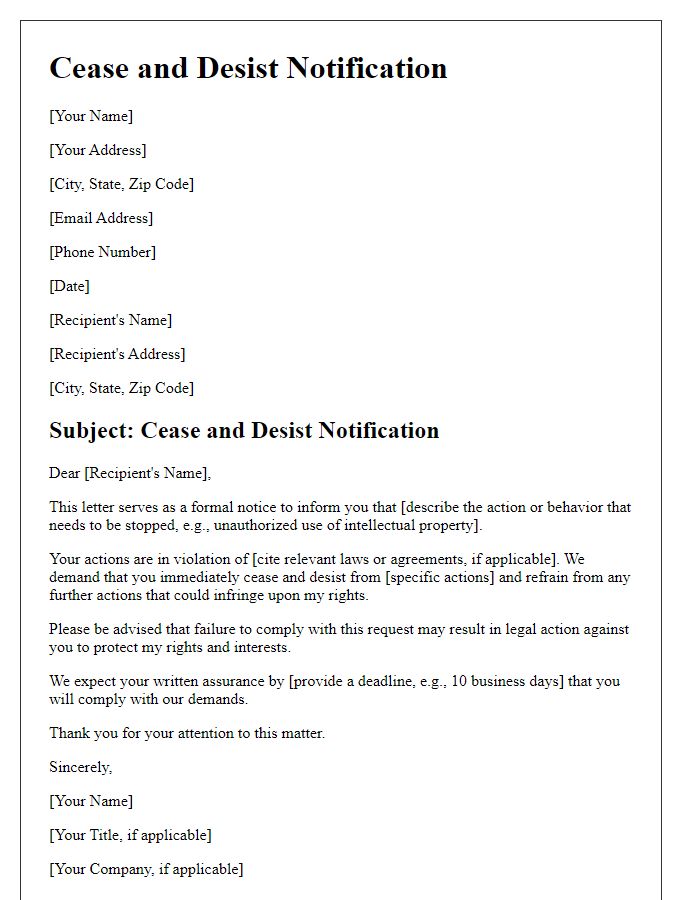If you've ever found yourself needing to put an end to unwelcome activities, a cease and desist order is your go-to solution. These legal documents serve as formal requests to halt specific actions that infringe on your rights or interests. It's important to clearly convey the details and consequences involved, ensuring that your message is both firm and precise. Ready to learn how to craft an effective cease and desist letter? Let's dive in!

Legal Basis and Jurisdiction
Cease and desist orders are formal requests to halt illegal or unwanted activities, often originating from legal statutes or regulations. Jurisdiction, the authority granted to a legal body to administer justice within a defined sphere, is typically established by geographic location or subject matter. Legal bases can encompass various laws, such as intellectual property rights, torts, or contracts, which provide grounds for action. For example, copyright infringement under the 17 U.S.C. SS 101-810 (U.S. Copyright Act) may give rise to a cease and desist order. It is crucial to outline the specific legal provisions that support the demand for cessation and specify the court or legal body governing the matter, ensuring clarity regarding which laws apply and which jurisdiction oversees enforcement.
Specific Violation Details
A cease and desist order serves as a formal request to halt specific activities that infringe upon legal rights. Instances such as copyright infringement (unauthorized use of copyrighted material) or trademark violation (use of a registered trademark without permission) may be highlighted. The violation may involve a particular event (such as a public performance) or context (like online distribution) that breaches intellectual property laws. Geographic relevance may also apply; for example, actions occurring in New York might violate state-specific regulations. The order typically outlines potential consequences, including legal action, if the infringing activities do not cease within a specified time frame, often 14 to 30 days. Proper documentation and evidence (such as screenshots or physical copies) are critical to support claims.
Immediate Demand for Cessation
Cease and desist orders serve as formal legal requests aimed at halting specific activities that infringe on rights or violate regulations. Often issued by legal authorities or affected individuals, these orders highlight actions such as copyright infringement, trademark misuse, or harassment. Key details typically include the name of the party involved, a clear description of the infringing activity, and a demand for immediate cessation of the behavior. Potential consequences for non-compliance, such as legal action or further penalties, are also outlined to emphasize the seriousness of the demand. Such orders are critical in protecting intellectual property rights, ensuring compliance with legal standards, and preventing further harm in various sectors.
Consequences of Non-compliance
Failure to comply with a cease and desist order may result in legal consequences, including potential lawsuits and financial penalties. Non-compliance can lead to court-imposed injunctions, preventing further unauthorized actions and potentially resulting in substantial damages awarded to the aggrieved party. Ongoing violations might also attract interest from regulatory agencies, which could initiate investigations and impose fines according to relevant laws, such as trademark infringement statutes or local business regulations. Additionally, continued non-compliance can damage reputations within industries, leading to loss of customer trust and future business opportunities, particularly in competitive markets like technology and retail.
Contact Information for Resolution
A cease and desist order typically requires clear communication of intent and details for resolution. Important elements include the sending party's name, address, and contact numbers, alongside the recipient's details. Additionally, an effective resolution pathway includes specific contact information, often with an email address, phone number, and a designated representative's name, such as a legal counsel or compliance officer. This ensures that the recipient can quickly reach out for clarification or resolution, facilitating a more efficient process in addressing any alleged offenses or concerns raised in the order.
















Comments